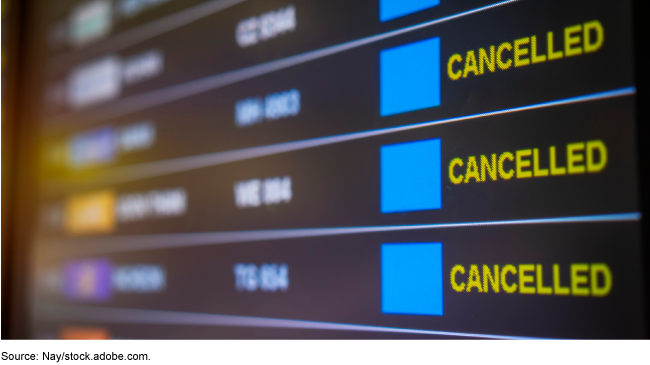Airline Passenger Protections: Observations on Flight Delays and Cancellations, and DOT's Efforts to Address Them
Fast Facts
When demand for air travel dropped during the COVID-19 pandemic, commercial airlines took steps to cut costs, such as suspending hiring and reducing staff.
The industry has largely recovered, but cancellations and delays have persisted—affecting millions of passengers. Generally, cancellations and delays in late 2021 were due to factors that were within an airline's control, such as airplane maintenance or lack of crew.
The Department of Transportation has improved public information about passengers' rights. DOT also stepped up its oversight—for example, by meeting regularly with airlines to help ensure realistic flight scheduling.

Highlights
What GAO Found
Flight cancellation rates in the last 6 months of 2021 outpaced 2018 and 2019 rates despite 14 percent fewer scheduled flights, according to GAO's analysis of data from the Department of Transportation (DOT). Increased cancellation rates continued through April 2022, the most recent data at the time of GAO's analysis. In contrast, flight delays in the last 6 months of 2021 remained at similar rates compared to 2018 and 2019. According to DOT data, factors within the airlines' control (e.g., aircraft maintenance or lack of crew) were the leading cause of cancellations from October through December 2021 as well as in April 2022 and airline-caused delays increased for nearly all airlines in the last half of 2021.
Percentage of Airline-Caused Cancelled Flights, January 2018 through April 2022

Stakeholders said that operational challenges, including a need for additional pilots and crew, have made it harder for airlines to manage flight disruptions. In response, airlines added new staff, opened new training facilities, and reduced the number of scheduled flights, among other things. Airline representatives GAO interviewed said they attempt to accommodate affected passengers, offering meal and hotel vouchers. However, consumer advocate representatives were generally not satisfied with airlines' responses, noting the significant inconvenience passengers experienced, such as missing important events.
DOT and the Federal Aviation Administration (FAA) are taking several actions to address flight disruptions. For example, DOT and FAA met with airlines to discuss disruptions and airlines' customer service obligations. In early September 2022, DOT released its Airline Customer Service Dashboard, which shows the services and amenities U.S. airlines provide if the airline causes a delayed or cancelled flight. Additionally, DOT monitors chronically delayed flights—a long standing practice. Over the course of GAO's review, DOT enhanced its oversight of airline-scheduling practices. Specifically, DOT began analyzing system-wide cancellation and on-time performance data and routinely meeting with airlines to review their scheduling and operational performance. DOT plans to continue these actions.
Why GAO Did This Study
As air travel in the U.S. began to recover from the pandemic in mid-2021, U.S. passenger airlines experienced frequent flight disruptions. These flight disruptions, including delays and cancellations, continued into 2022 and affected millions of passengers. Industry observers raised questions about airline-scheduling practices, as well as the role of DOT in enforcing consumer protections.
GAO was asked to determine key changes in the U.S. passenger airline industry resulting from the pandemic. This report examines (1) trends in and causes of flight disruptions before and after the pandemic; (2) challenges airlines faced managing and responding to flight disruptions; and (3) FAA and DOT actions to help address them.
GAO analyzed DOT data on U.S. airline operations from January 2018 through April 2022. GAO reviewed relevant federal statutes and regulations. GAO interviewed DOT and FAA officials, as well as representatives from U.S. passenger airlines, unions, and consumer organizations selected based on background research and prior GAO work, among other things.
GAO's draft report recommended that DOT use network-level (i.e., system-wide) data to identify instances of potential unrealistic scheduling. In response, DOT provided additional information about its recent analysis of airlines' scheduling practices. As a result, GAO removed the recommendation and modified the report accordingly.
For more information, contact Heather Krause at (202) 512-2834 or KrauseH@gao.gov.
